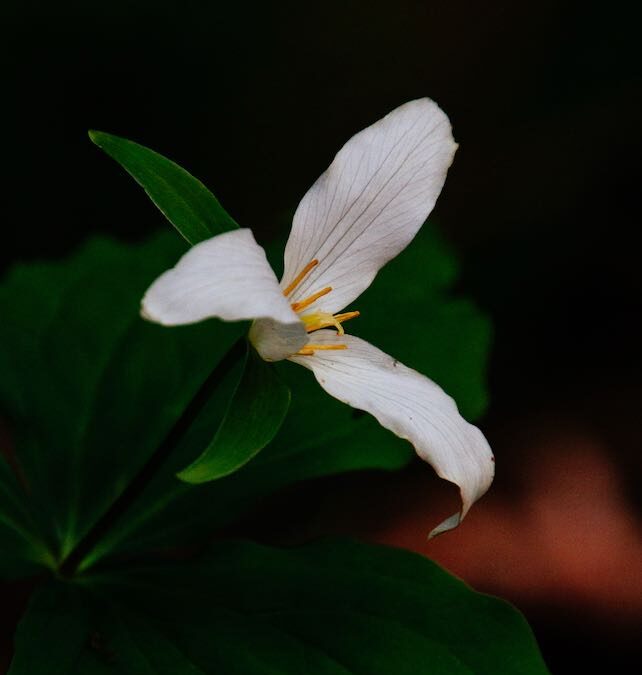Nana, my mother’s mother, was the maven of molasses creams, maple syrup, piggy-back rides, pickled beets, knits and purls, boiled jelly, tomatoes, and trilliums. In other words, she tilled the land, fed the family, created textiles, designed garden beds, and invented entertainments.
On June afternoons, I picked strawberries with Nana and my mother. On my knees in the farmer’s field, I lifted vines to uncover fruit, then gently pinched and placed each one in my child’ s-size woven basket. Wisconsin’s sun ran a stream of sweat down my back. “Go ‘head and try some,” Nana would say. “The farmer don’t care how much you eat.”
As I sampled and gathered, ruby juice stained my fingers, and straw stalks hash-marked my knees. When I found a misshapen berry, I showed Nana. I liked to hear her say, “Oh, look, a sheep’s tit.”
On fall mornings in her kitchen, I eased Ball canning jars, tops, and lids into a vat of boiling water. The sterilized containers would hold food from Nana’s garden. Some days, my mother ladled heirloom and modern tomatoes—peeled, cut, and stewed—into the jars. They steamed the room with their acid tomato-y aroma. Other days, she poured juice from bulbous, thick-skinned purple grapes, cooked, mashed and strained through cheesecloth.
My treat for a morning’s work was Nana’s molasses creams, a thin brown cake covered with powdered sugar frosting, cut in squares from a rimmed baking sheet. The snack passed the time as we waited for our jars to seal. Soon, a vacuum pressure pulled down each canning lid and snapped the air with its melody of …pop…pop…pop.
Our work complete, Nana shooed me outside where I stood on the porch step so she could lift me onto her back. Not much taller than I was, she trotted off on stout, thick legs, hands behind my knees, calling, “Giddyup,” as we galloped the front yard.
In her youth, Nana worked for a doctor, tending patients, learning to heal. She begged to be a nurse and care for others. But she was the youngest, one of a dozen children born to a nineteenth-century farm family. The study of medicine was forbidden, and Nana blamed her sister Elsie.
As the eldest, Elsie made the rules and issued orders. Their mother apparently condoned the arrogance and allowed her to govern. Wielding power, Elsie became obsessed with one purpose: to control, dominate, and minimize her only sister.
Nana found favor with her father and brothers. They coddled her with whittled toys and homemade dolls and took her on odd jobs and travels. Elsie retaliated. She withheld food, issued insults, denied a place at the table. Their quarrel was long and extended into adulthood. Years past youth, Elsie resented Nana’s marriage while she remained the spinster.
As a child, I thought Elsie sounded like Cinderella’s stepsister, a fairy tale villain. I knew nothing of Freud, mental illness, bullying, or harassment. Now, having experienced other family narcissists, I recognize Elsie’s lack of empathy, her sense of entitlement, need for control, and a haughty attitude. And I smell her damage, like a vat of spoiled cabbage with an odor that can’t be washed away. Years after Nana raised five children, survived the Depression, and buried a husband and son, she would speak of Elsie’s hateful words and spiteful actions. The wound had festered for decades.
Elsie may have left a scar, but Nana was born a healer. For most of the 90 years, she fed her family with tomatoes, grapes, and strawberries. She created comfort with molasses creams and piggy-back rides. She established roots for trilliums, phlox, and progeny.
~~~
When Wisconsin’s May is brackish, and my rubber-soled boots skid on musty leaves, trilliums caper the forest floor. With lively bracts and alabaster flowers, they dance on thin brown stalks. Their performance, confident but brief, is a trio of petals, leaves, and seed pods. When trilliums appear in the woods, they also erupt in my yard. There, on the north side of an incline, shaded by a neighbor’s tree, they bloom quiet and elegant, tucked milky-white above recently green foliage. My grandmother, Nana, is the source of my trilliums. She divided hers and shared with my mother, who divided hers and shared with me.
For trilliums to produce flowers, they must mature for five or ten years, be nourished with rich organic matter, and live in an environment free of stress. Also, they must not be abused, perhaps by neglect or mishandling. When white buds do bloom, their performance is brief, like the introduction to a ballet. One of nature’s stars, they shine brighter with a strong supporting cast, in this case, a ground cover of ferns and moss. Poignant and succinct, the blooms exit swiftly to prepare for next year.
Trillium derives its name from the plant’s characteristics. Nearly all of its parts come in threes—leaves, flower petals, seedpods, and blooming styles—upright, nodding, or drooping. Trilliums are not unique in this design. Nature favors a trinity—primary colors; pas de trois; ternary song form; Father, Son, and Holy Ghost; mother, daughter, granddaughter.
The blossoms appear delicate, but they are hardy. And although sturdy, they exist in a small stretch of days. Then the plant lies dormant, reproducing seeds and rhizomes, making its daughters and granddaughters and great-granddaughters. Year after year, trilliums survive harsh winters to return and flower again. They survive up to 25 years, and I wonder what that is in people years. Or if they can pass on unique characteristics to their offspring.
~~~
Nana’s cedar hope chest lives in my front room. It was a wedding gift from Grandpa Pete to his soon-to-be-bride. Beautifully boxy, with a rustic natural finish, four chunky feet raise it from the floor. When I open it, the lid glides on hinges. When I close it, the top overhangs its edges, a protection from dust and debris.
On the outside, Grandpa Pete bound its corners with copper, tiny nails hammered vertically every quarter inch. This metal strip, with an age-worn patina, is now over 100 years old. It reminds me how long some things can last—a story, a plant, a recipe, a hurt.
My aunt found the chest in Nana’s garage, up in the rafters. It was crusted with dust and age, nails missing from the copper, hinges bent catawampus. Scratched, stained, and dented, it wore evidence of life’s offenses. A nick from a child’s shoe, a scrape from a teenager’s rucksack, a water ring from a guest’s beer bottle. My aunt wanted to throw it out, but I believed it had survived insults and still retained its bones. I pictured the chest in its prime: newly constructed, redolent with fresh cedar sawdust, a place to hold bed sheets and tablecloths and memories.
My husband saw potential too, and cared for it in his workshop. With sandpaper, wax, cloth, and nails, he rediscovered its beauty and restored its strength. He revealed its character and resilience, never really lost, as he removed splinters, replaced hardware and polished grain.
The cedar chest now holds knitted blankets and quilted coverlets. When I am chilly, I go there for comfort and warmth, and when I open the lid, cedar releases its warm scent of age and tradition. I reach in for a covering and pull out more than stitches and cloth.
Nancy Jorgensen is a Wisconsin writer. Her 2019 memoir, “Go, Gwen, Go: A Family’s Journey to Olympic Gold,” is published by Meyer & Meyer Sport. Her choral books are published by Hal Leonard Corporation and Lorenz Corporation. Other works at Prime Number Magazine, Cagibi, CHEAP POP, Brevity blog, and elsewhere.


